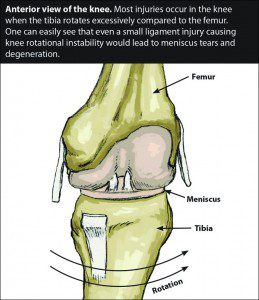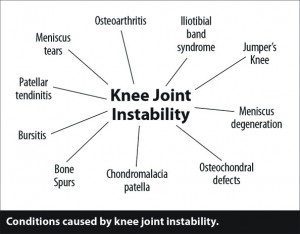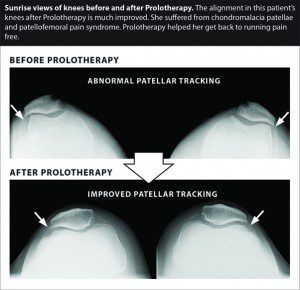By Debra K. Brinker, RN

Most of us walk and go about our daily activities without much thought to the structure and stability of our knees, until they begin to hurt or we sustain an injury from a fall or while playing sports. Injuries to the ligaments of the knee are quite common. How often do we hear of athletes missing their entire season due to injuries such as an anterior cruciate ligament (ACL) tear? The concern is greater than just the ACL tear because any change in the structures of the knee, including the muscles, tendons, ligaments, menisci, cartilage and bone, will set the knee joint up for further instability and injury. (See Figure 1.) Secondary injury can occur over time as the instability of the knee joint puts too much pressure on additional structures. Some of the conditions which may arise due to instability of the knee joint include patellar tendonitis, meniscal tears, runner’s knee, patellofemoral pain syndrome, chondromalacia patella, and osteoarthritis. (See Figure 2.)
To understand our joints, think of cabinet doors
Cabinet doors are similar to two adjacent bones. In order for the doors to glide properly, and not hit each other in the middle, the hinges must be secured. If a screw in one hinge becomes loose, it will eventually effect the other screw and the hinge loosens. This allows the door to swing too far out, wobble, and hit the other cabinet door. It will also put additional pressure on the other hinges, eventually causing them to loosen as well. All the while, the doors are hitting, wearing away at the finish or warping the wood at the site of contact.

When it comes to our joints, the ligaments are like the screws that hold the hinge in place. Ligaments play a crucial role in the stability of the knee, yet are particularly vulnerable when the loads placed on them exceed their allowed elasticity, which then results in overstretching and a destabilized joint. This excessive bone movement, just like with a wobbly cabinet door, puts added pressure on the surrounding structures. The body tries to protect the joint by swelling it, overgrowing bone (spurs), or by the over-engagement of the surrounding muscles, causing spasms/tightness.
Treatment for joint pain must address
the loose ligaments
Continuing with the hinge analogy, injured ligaments do not heal well on their own, just like a screw is not going to tighten itself. To fix the wobbly cabinet door, the best option is to tighten the loose screw with a screwdriver. Therefore, a treatment for effective long term results must act as a screwdriver. However, most conservative treatments such as corticosteroid and hyaluronic acid injections or NSAIDs focus only on short-term relief of symptoms. Corticosteroids and NSAIDs have both been linked to the acceleration of the arthritic process, among other deleterious side effects, and hyaluronic acid has not been shown to result in benefit.1 When these treatments fail to resolve the pain, symptoms and progression of the disease process, surgery is often the next step. Although surgical intervention may be needed in some cases, surgical arthroscopy for osteoarthritis has been shown to lack benefit,2 even when compared to exercise and other non-operative treatments.3 Arthroscopic partial meniscectomy for meniscal injuries has also been questioned in studies due to lack of efficacy4 and a strong association with acceleration of the arthritic process.5 In the example of the hinge, these treatments would be like oiling the hinge, sanding the door, or replacing the door. These would not be ideal home improvement choices, when a simple screwdriver is needed.

The treatment that best relates as a screwdriver for a loose hinge is Prolotherapy, a regenerative injection treatment that targets the ligaments and soft tissues. It promotes the long term repair of the connective tissues, allowing the joints to glide properly and therefore relieving pain and the long term effects of joint instability. (See Figure 3.)
Referneces:
1 American Academy of Orthopedic Surgeons Board of Directors. Treatment of osteoarthritis of the knee. Evidence-based guideline, 2nd edition; May 18, 2013.
2 Kirkley A, Birmingham TB, Litchfield RB,et al. A randomized trial of arthroscopic surgery for osteoarthritis of the knee. N Engl J Med 2008;359(11):1097-1107.
3 Marsh JD, Birmingham TB, Giffin JR, et al. Cost-effectiveness analysis of arthroscopic surgery compared with non-operative management for osteoarthritis of the knee. BMJ Open 2016; 5:e009949.doi:10.1136/
bmjopen-2015-009949
4 Khan M, Evaniew N, Bedi A, Ayeni OR, Bhandari M. Arthroscopic surgery for degenerative tears of the meniscus: a systematic review and meta-analysis. CMAJ.2014;186(14):1057-1064.
5 Berthiaume MJ, Raynauld JP, Martel-Pelletier J, et al. Meniscal tear and extrusion are strongly associated with progression of symptomatic knee osteoarthritis as assessed by quantitative magnetic resonance imaging. Ann Rheum Dis 2005;64(4):556-563.
Prolotherapy Specialists
CaringMedical.com
239-303-4546
with locations in Fort Myers and Chicagoland







